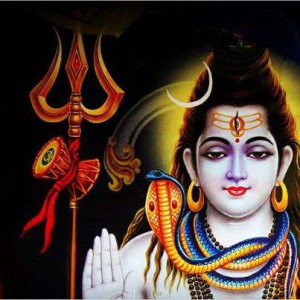
Shiva, the third of the Trimurti is the Hindu god of desolation whose role is to tear down the universe in order for things to be re-created. In another way, he destroys the illusions, imperfections and old ideas of the world to make way for positive changes. Every beginning by necessity must have an ending. By destruction, nothing but the illusion of individuality alone is tampered. Thus the power of destruction associated with Shiva has a purifying sense both on a personal level when we realize reality clearer in the face of difficulty, as on a universal level, destruction opens the path for a new creation of the universe, a new opportunity for the beauty of universal illusion to unfold. In Shiva, the art of meditation takes its most absolute form.
During deep meditation or the state of samadhi it is said that even the object of the meditation transforms into its formless essence. Thus Shiva stands for letting go of all worldly forms to emphasize the path of the ascetic yogi.
Shiva is also worshipped in many forms, as the Aghora who resides in the cremation grounds, as Ishana often represented by the shivalingam, as Tatpurusha, seen meditating, as the eternal Shiva or Varna Deva and Rudra, the old wrathful form. Another manifestation of Shiva is said to be Hanuman, the definitive karma yogi, in a never-ending selfless service to Ram. Shiva is also related to Indra in the form of Varna Deva.
An interesting form of Shiva is the Nataraja.
“Nataraja’s dance represents both the destruction and the creation of the universe and the cycle of birth, death and rebirth. Defeated under his feet is the demon of ignorance called Apasmara Purusha, the enemy of enlightenment (caused by forgetfulness).One of his hands points towards the lifted foot, indicating the release from earthly bondage of the devotee. The fire represents the final destruction of creation, but the dance of the Nataraja is also an act of creation, which arouses dormant energies and scatters the ashes of the universe in a pattern that will be the design of the ensuing creation.”-The Santana Dharma Society
While the most worshiped form of Shiva is his unborn, invisible self, the Shiva Lingam.
Through profound understanding of this symbol, the mystery of creation can be understood as an act of love.
Hinduism is an abode of many other deities symbolizing every outlook of human life and are mostly the incarnation of these first three. Thus the cycle of life and universe is understood through the acts of the Trimurti.
“Brahma brings the universe into being through his thoughts. The world then passes through a Mahayuga, or great age that lasts 4,320,000 years. The Maha Yuga contains four yugas, or ages. Each is shorter and more immoral than the one before, from the Krita Yuga—Brahma’s golden age—through two intermediate ages under Vishnu’s protection to the Kali Yuga—Shiva’s dark age.
Each dark age in turn gives way to a new golden age and the cycle of the Maha Yuga repeats a thousand times. Then Shiva destroys all life with scorching heat and drowning flood and the earth remains empty while Vishnu sleeps. After a thousand Maha Yugas, a lotus flower emerges from Vishnu’s navel, and it becomes Brahma, ready to perf



No comments:
Post a Comment
Note: Only a member of this blog may post a comment.